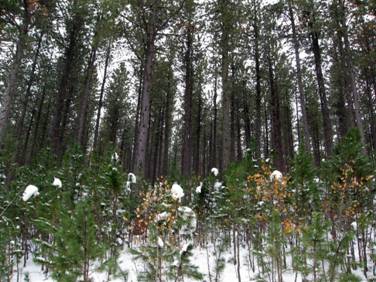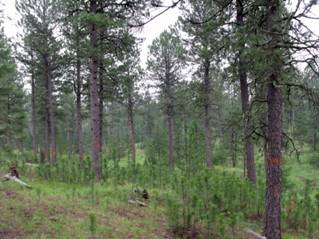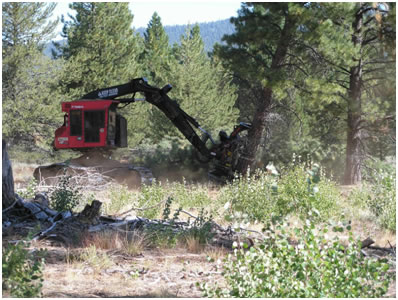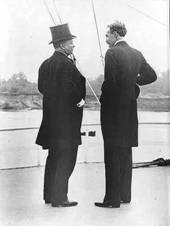Black Hills Forestry
Forestry 101
To help make things a little easier on everyone, our discussions about forestry, management, and the forest products industry will be generally confined to the context of the Black Hills National Forest. As you may already know, the issues that frame national forest management – especially here in the Black Hills – are complex enough on their own! There are, however, many resources on the Web that can provide you with information about all of forestry’s myriad forms.

This photo illustrates the typical, positive results from forest management in the Black Hills. This area has reduced wildfire hazard and risk of infestation by mountain pine beetles.
 So, what is forestry? In a few words, forestry is the science, art, business, and practice of conserving and managing forests and forest lands to provide a sustained supply of forest products, forest conditions, or other forest values desired by the forest owner (cf. Ford-Robertson, 1971). More specifically, forestry combines a functioning scientific knowledge of soils, hydrology, wildlife and habitat, plant physiology and natural history, biometrics, and ecosystem processes, with the application of land surveying, timber harvest systems and operations, information technologies, and business. In this sense, forestry is where the rubber of scientific knowledge meets the road of achieving ecological, social, and economic land management objectives.
So, what is forestry? In a few words, forestry is the science, art, business, and practice of conserving and managing forests and forest lands to provide a sustained supply of forest products, forest conditions, or other forest values desired by the forest owner (cf. Ford-Robertson, 1971). More specifically, forestry combines a functioning scientific knowledge of soils, hydrology, wildlife and habitat, plant physiology and natural history, biometrics, and ecosystem processes, with the application of land surveying, timber harvest systems and operations, information technologies, and business. In this sense, forestry is where the rubber of scientific knowledge meets the road of achieving ecological, social, and economic land management objectives.
 As you might imagine from its extremely broad definition, forestry is a tremendously diverse and internally specialized profession. Each and every forest of the world is biologically unique; accordingly, so is the practice of forestry therein. In the western US alone, for example, one might find every forest type from bottomland hardwoods and ponderosa pine in low elevations, to lodgepole pine, aspen, and Douglas fir in middle elevations, to spruce-fir and hemlock-fir in the upper-most elevations. Each of these very distinct forests is managed in a different fashion, which is tailored to fit the natural processes that shaped them and the physiological traits of the tree species themselves. Adding another layer of complexity, each forest landowner – be they private citizens, state or federal government agencies, forest products companies, etc. – has a unique set of objectives for managing their forestlands. Forestry is the vehicle that carries forest land from its present-day condition toward tomorrow’s objectives, as defined by the landowner.
As you might imagine from its extremely broad definition, forestry is a tremendously diverse and internally specialized profession. Each and every forest of the world is biologically unique; accordingly, so is the practice of forestry therein. In the western US alone, for example, one might find every forest type from bottomland hardwoods and ponderosa pine in low elevations, to lodgepole pine, aspen, and Douglas fir in middle elevations, to spruce-fir and hemlock-fir in the upper-most elevations. Each of these very distinct forests is managed in a different fashion, which is tailored to fit the natural processes that shaped them and the physiological traits of the tree species themselves. Adding another layer of complexity, each forest landowner – be they private citizens, state or federal government agencies, forest products companies, etc. – has a unique set of objectives for managing their forestlands. Forestry is the vehicle that carries forest land from its present-day condition toward tomorrow’s objectives, as defined by the landowner.
 So, you may be asking yourself, “How exactly do foresters go about practicing their ‘art and science?'” Well, once the stages of scientific forest assessment and management planning are completed, foresters utilize a number of management techniques to reach a landowner’s desired objective. These include many forms of timber harvest, thinning, tree planting, and prescribed burning, to name a few. In the Black Hills, clear-cutting is nearly non-existent. Instead, the idea is to thin the forest in perpetuity cutting some trees now, allowing new trees to establish and letting the existing trees continue to grow, then repeating the process. As you can see, this system involves several intermediate thinning treatments that open up the forest and allow trees to grow vigorously.
So, you may be asking yourself, “How exactly do foresters go about practicing their ‘art and science?'” Well, once the stages of scientific forest assessment and management planning are completed, foresters utilize a number of management techniques to reach a landowner’s desired objective. These include many forms of timber harvest, thinning, tree planting, and prescribed burning, to name a few. In the Black Hills, clear-cutting is nearly non-existent. Instead, the idea is to thin the forest in perpetuity cutting some trees now, allowing new trees to establish and letting the existing trees continue to grow, then repeating the process. As you can see, this system involves several intermediate thinning treatments that open up the forest and allow trees to grow vigorously.
 These thinnings also make way for the next generation of trees, which grow up underneath the shelter of their elders (hence the name, shelterwood). Often, each shelterwood or seed tree harvest is followed by some form of prescribed fire; either ‘jackpot’ burning of piled logging debris or ‘broadcast’ burning of dispersed limbs and twigs across a larger area. When the trees have reached maturity, and the regenerating trees beneath them have taken a firm hold, the mature trees are removed to allow their progeny to take over. The shelterwood/seed tree system is like many others in forestry — it’s a cycle, from beginning to end, of a tree’s life. This ensures that we’ll never run out of trees, that people will never run out of wood, and that the forest is maintained in a healthy and vigorous condition.
These thinnings also make way for the next generation of trees, which grow up underneath the shelter of their elders (hence the name, shelterwood). Often, each shelterwood or seed tree harvest is followed by some form of prescribed fire; either ‘jackpot’ burning of piled logging debris or ‘broadcast’ burning of dispersed limbs and twigs across a larger area. When the trees have reached maturity, and the regenerating trees beneath them have taken a firm hold, the mature trees are removed to allow their progeny to take over. The shelterwood/seed tree system is like many others in forestry — it’s a cycle, from beginning to end, of a tree’s life. This ensures that we’ll never run out of trees, that people will never run out of wood, and that the forest is maintained in a healthy and vigorous condition.
What is a National Forest?
 We refer to our neck of the woods as the ‘Black Hills National Forest’. The words ‘national forest’ have special meaning, a unique meaning among other kinds of public lands, and a meaning very much apart from things like National Parks, Wildlife Refuges, Wilderness, and State Parks and recreation areas.
We refer to our neck of the woods as the ‘Black Hills National Forest’. The words ‘national forest’ have special meaning, a unique meaning among other kinds of public lands, and a meaning very much apart from things like National Parks, Wildlife Refuges, Wilderness, and State Parks and recreation areas.
The late 1800’s were a time of rapid growth and expansion for our Nation. We were pushing back the western frontier, defining our national identity, and beginning to build what was to become the largest economy in the world. Timber was one resource that fulfilled the needs of economic growth. However, this period of time was also characterized by unchecked exploitation of the forest resource, and concern arose surrounding the prediction that the United States would run out of timber in the near future.
In response to this concern, several policy leaders of the time came together to ensure that all future generations would be able to enjoy the natural and economic benefits of our Country’s abundant forests. The most famous of these men was President Theodore Roosevelt; other names you might recognize include John Muir, Gifford Pinchot, and Aldo Leopold. Though not always in complete agreement, together, they forged the way for the creation of a system of federally-administered forest reserves. The reserves, over time, came to form the National Forest System; the Black Hills, having been designated a forest reserve in 1897, were transferred to formal National Forest status in 1905. Much has changed since then, but today these lands under balanced management that provides benefits to society and the economy, while maintaining their beauty for generations to come.
“The forests, like perennial fountains, may be made to yield a sure harvest of timber, while at the same time all of their far reaching beneficent uses may be maintained unimpaired.”
-John Muir (Founder of the Sierra Club), 1895
Here are some additional FAQ’s to help better frame the nature of national forests:
What defines a national forest?
National forests are a nationwide system of publicly owned, federally-administered lands that are actively managed for public benefit under a set of objectives called ‘multiple-use’. Since its inception, the National Forest System has grown to include 175 national forests and grasslands, encompassing 191 million acres (or an area the size of Texas). A complex suite of laws and regulations govern the management on these lands today, but they have their beginnings in a very simple tenet: “wise, scientific use” (1905 Transfer Act). The operable word being, ‘use’ – not ‘preserve it as though it was a trinket to admire in a display case’ – but ‘use’. National forests, by their definition, are public lands that work for a living.
What is “multiple-use”?
Multiple-use is a set of objectives for land management based upon the idea that the forest provides all sorts of benefits to all sorts of people. Although the concept has evolved considerably over time, multiple-use’s primary components are clean air and water, abundant wildlife and habitat, forest products, scenic beauty, minerals, livestock range, and the many forms of recreation. The origins of this concept date back to the Multiple-Use Sustained-Yield Act of 1960. However, multiple-use has persisted through the many other pieces of legislation that have since come to pass, and it remains the key fixture in the direction of national forest management.
What other laws and regulations are involved in the management of national forests?
Multiple-Use Sustained-Yield Act (MUSYA, 1960):
we’ve briefly discussed this topic already, but, in essence, the MUSYA obligates the Forest Service to give equal consideration to all the myriad benefits the public can derive from national forests. MUSYA’s other component is its mandate that yields of timber and forage from national forests shall be sustained and non-declining in perpetuity; this ensures that we’ll never over-harvest or run out of trees. To read the text of this law, go to the Library of Congress and search for 16 USC Secs. 528-531, or Public Law 86–517.
National Environmental Policy Act (NEPA, 1969):
despite the arduous and lengthy procedural requirements NEPA has grown to entail for the Forest Service, the roots of this law were sensible and concise. Essentially, NEPA says that the Federal government must fully disclose the potential environmental impacts of any actions it may propose to carry out, and must also consider input from the general public on its proposals. To read the text of this law, go to the Library of Congress and search for 42 USC Sec. 4321-4347, or Public Law 91-190.
Endangered Species Act (ESA, 1973):
the ESA, again, was a piece of legislation enacted with well-meaning and honorable intentions. The goal is to identify wildlife species whose existence is genuinely threatened, and implement a plan that sees those species through to recovery. Most often, unfortunately, neither of those goals are satisfied. Species are commonly petitioned for ESA protection on poor scientific grounds and with less-than-honorable objectives on the part of the petitioners. Worse, few species that gain “protected” status ever show tangible recovery, and “recovery efforts” invariably revolve around causing families, communities, and businesses untold suffering and hardship. Many in Congress and among the public favor a major overhaul of this law. To read the text of this law, go to the Library of Congress and search for 16 USC Secs. 1531-1544, or Public Law 93-205.
Forest&Rangeland Renewable Resources Planning Act (RPA, 1974):
the RPA arose from the idea that, in order to ensure sustainable management and flows of resources from the national forests, the Forest Service needed a centralized way to regularly assess the state of natural resources on all their lands. RPA requires the agency to compile data on things like forestland ownership, forest growth, forest harvests, etc, etc, and make this information available to the public. To read the text of this law, go to the Library of Congress and search for 16 U.S.C. Sec. 1671, or Public Law 93-378 (Amended PL 94-588, and PL 106–580).
National Forest Management Act (NFMA, 1976):
in the late 1970’s, it was decided that each national forest ought to produce a plan, commonly referred to as a Forest Plan, to provide its management direction over the long-term. Each individual project (be it a new road, a timber sale, a grazing permit, or a recreation improvement) that a given national forest undertook would then be directed at achieving the goals and objectives set out as the long-term “vision” for the forest in the Forest Plan. The NFMA established the cornerstone components of forest planning, and provided the basic framework of scientific analysis that a national forest was required to complete as part of constructing its Plan. To read the text of this law, go to the Library of Congress and search for 16 USC Secs. 1600-1614 (amended 1978, 1980, 1981, 1983, 1985, 1988 and 1990), or Public Law 94-588.
Internal implementing procedures, policies, and rulemakings:
The Forest Service has many, many, many internal regulations and policies; too many to begin to discuss here. Essentially, for each piece of federal legislation that may be applicable to management on the National Forest System, there exist regulations. There are still more regulations as you get past the Washington, D.C. level of the Forest Service and down to the Regional- and Forest-level.
Is a national forest different from a national park?
Absolutely. Where National Forests are actively managed by the USDA Forest Service to produce multiple benefits, National Parks are managed by the Department of Interior’s National Parks Service as leave-alone preserves, maintaining the natural character of the area within the park’s boundaries. Nationwide, the National Parks System includes 379 parks, refuges, and monuments covering 83.6 million acres.
What about State parks?
State parks are managed under a tremendously varying suite of objectives. Some are recreation-only, some are wildlife preserve areas, and still others produce resources such as livestock forage and forest products. Their management is, of course, set at the state level. For information on South Dakota’s State Parks, see the Game, Fish & Parks web site; for information on Wyoming’s State Parks, see the Department of State Parks & Cultural Resources web site.
